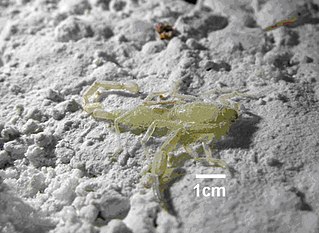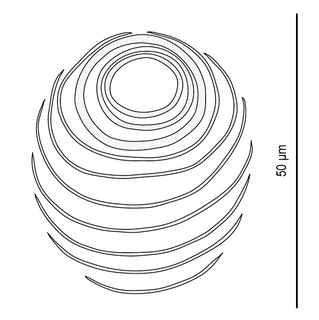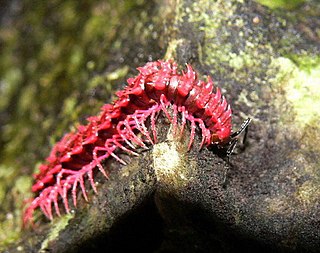 W
WAkrav israchanani is an extinct species of scorpions from the Ayyalon Cave in Israel.
 W
WCalydiscoides euzeti is a species of monogenean of the family Diplectanidae.
 W
WDesmoxytes purpurosea also known as dragon millepede, is a spiny and toxic millipede named for its vivid pink color. It was formally described in 2007 from a specimen collected at the Hup Pa Tard limestone cavern in the Uthai Thani Province of Thailand. Among the largest species of its genus, the adult millipede is approximately 3 cm (1.2 in) long. It lives in the open on leaf litter. Large numbers of them occur after rain showers. The millipede has glands that produce hydrogen cyanide to protect it from predators, which causes it to smell like almonds. Its toxicity is advertised by its aposematic color.
 W
WDugesia artesiana is a species of dugesiid triclad found in Queensland, Australia.
 W
WCyclida is an order of fossil arthropods that lived from the Carboniferous to the Cretaceous. Their classification is uncertain, but they are generally treated as a group of maxillopod crustaceans.
 W
WMadracis auretenra, commonly known as the yellow finger coral or yellow pencil coral, is a colonial species of stony coral in the family Pocilloporidae. It is a fairly common species and is found in the Caribbean Sea and western Atlantic Ocean. At one time this species was not recognised, but it was split from Madracis mirabilis on the grounds of morphology and depth range.
 W
WMalo kingi or the common kingslayer is a species of Irukandji jellyfish. It was first described to science in 2007, and is one of four species in the genus Malo. It has some of the world's most potent venom, even though it is no bigger than a human thumbnail. As an Irukandji, it can cause Irukandji syndrome, characterized by severe pain, vomiting, and rapid rise in blood pressure.
 W
WPseudorhabdosynochus bouaini is a diplectanid monogenean parasitic on the gills of groupers. It has been described in 2007 by Lassad Neifar & Louis Euzet. The species has been redescribed by Amira Chaabane, Lassad Neifar, and Jean-Lou Justine in 2017.
 W
WPseudorhabdosynochus dolicocolpos is a diplectanid monogenean parasitic on the gills of groupers. It has been described in 2007 by Lassad Neifar & Louis Euzet. The species name refers to the size of the vagina and is derived from the Greek words “dolicos” meaning long and “colpos” vagina. The species has been redescribed by Amira Chaabane, Lassad Neifar, and Jean-Lou Justine in 2017.
 W
WPseudorhabdosynochus enitsuji is a diplectanid monogenean parasitic on the gills of groupers. It has been described in 2007 by Lassad Neifar & Louis Euzet. The name of the species honours French parasitologist Jean-Lou Justine . The species has been redescribed by Amira Chaabane, Lassad Neifar, and Jean-Lou Justine in 2017, from the type-material and additional specimens.
 W
WPseudorhabdosynochus maaensis is a diplectanid monogenean parasitic on the gills of the malabar grouper, Epinephelus malabaricus. It has been described in 2007.
 W
WPseudorhabdosynochus malabaricus is a diplectanid monogenean parasitic on the gills of the malabar grouper, Epinephelus malabaricus. It has been described in 2007.
 W
WPseudorhabdosynochus manifestus is a diplectanid monogenean parasite first found in host Epinephelus malabaricus near Nouméa, between its secondary gill lamellae. It can infest its host by the hundreds. It was ascribed that name because it was the most abundant species found while its descriptive study was taking place. As appreciated from studying juvenile specimens, the development of female organs precedes that of male organs in this species and is likely the case in other Pseudorhabdosynochus species.
 W
WPseudorhabdosynochus manipulus is a diplectanid monogenean parasitic on the gills of the malabar grouper, Epinephelus malabaricus. It has been described in 2007.
 W
WPseudorhabdosynochus marcellus is a diplectanid monogenean parasitic on the gills of the malabar grouper, Epinephelus malabaricus. It was described in 2007.
 W
WPseudorhabdosynochus maternus is a diplectanid monogenean parasitic on the gills of the malabar grouper, Epinephelus malabaricus. It has been described in 2007.
 W
WPseudorhabdosynochus sinediscus is a diplectanid monogenean parasitic on the gills of groupers. It has been described in 2007 by Lassad Neifar & Louis Euzet. The name refers to the absence of squamodiscs and is derived from the Latin “sine”, indicating absence, and “discus”, contraction of “squamodiscus”.
 W
WPseudorhabdosynochus sosia is a diplectanid monogenean parasitic on the gills of groupers. It has been described in 2007 by Lassad Neifar & Louis Euzet. According to Neifar & Euzet, the name of the species refers to Sosia, who in Plautus’ comedy Amphitryon confronts his double, and to the resemblance of the vagina of P. sosia to that of P. beverleyburtonae.